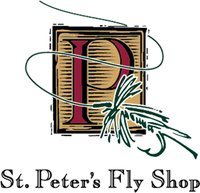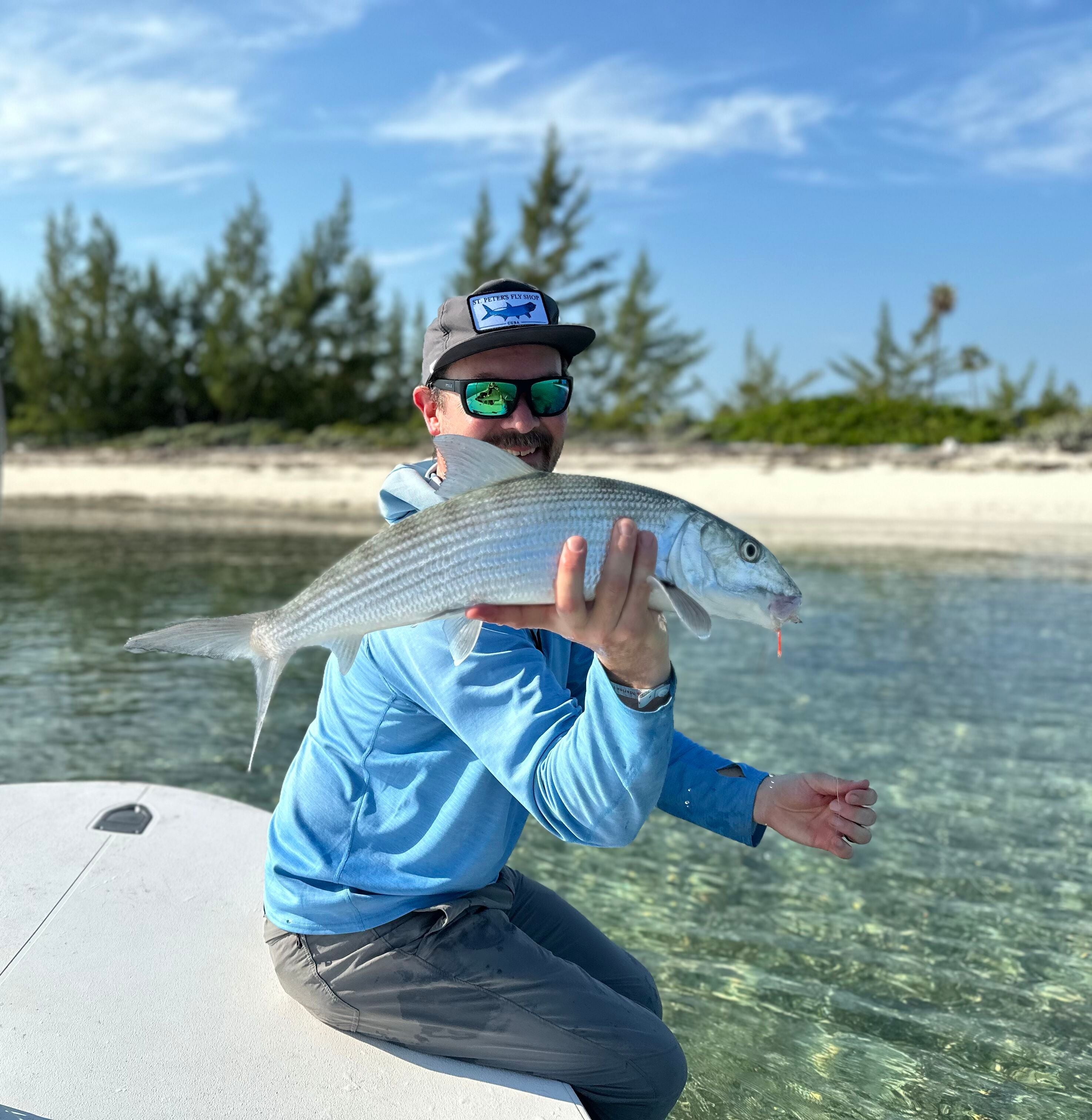Fly Fishing Cuba
Cuba Packing List
Personal Items / Gear
- Passport, and make sure that it expires more than 6 months after your trip!
- Cash – for spending money & tips
- Credit Card – (*inform your bank you are leaving the country*)
- Camera
- Garbage Bag - to pack wet clothing on the way home
- Bug Repellant
- Clippers
- Hemostat/Forceps
- Hook hone- for sharpening hooks
- Chest/Waist Pack for wade fishing- waterproof preferred
- Leaders & Tippets – refer below
- Flies, Fly Box – refer below
- Fishing Shirts(3-6 pairs) – quick dry and buggstopper
- Fishing Pants (3-6 pairs)- quick dry
- Shorts- quick dry
- Rain Jacket and pants
- Wading Boots- these need to be boots specifically designed for the flats with soles impermeable by sharp coral.
- Boat shoes or non making soles for boat
- Hat with a dark under bill
- Sandals – Flip flops
- Gear Bag to bring on the boat – waterproof preferred
- Cell phones- they do not work in Cuba for the most part except with Wifi.
- Waterproof Sunscreen
- Lip Balm with SPF protection
- Sun Gloves
- Stripping Guards
- Buff or Bandana for neck and face sun protection
- Polarized Sunglasses - and a spare pair if you have one
o Different light conditions merit different sunglass shades
- Contact Lenses, lens solutions, wetting solution
- Eyeglasses, reading glasses
- Sunglass cleaning wipes
- Medical Tape or “Nu-skin” – for your fingers from leader cuts
- Ear Plugs
- Prescription medication that you need
- Aspirin, Motrin
- A kit with Antibiotics, Imodium AD etc. for emergencies
- Zophran- great if you get motion sickness or sick
- First Aid Kit
- Anit itch cream
- Zap a gap for bad cuts
- Moisture Cream if hands dry out
- Wet Wipes- always handy to have when traveling
- Lighter for Cigars, cutter
- Small pocket knife- put in checked bag
- Small flashlight or headlamp
- Most hotels have the same power outlets as the US. Some locations have 2 prong or 3 prong outlets so adaptors may be advisable most hotels have 110v to 220v in Cuba
- Zip Lock bags for passport, camera gear, cigars, misc.
- Water Bottle - to reuse throughout the week
- Energy bars/granola bars
- Tortillas(a 6 pack for lunches) nice to make a burrito and easy to eat
- Hot Sauce
- Candies- additional items for your lunch- consider bringing 1 for your guide
- Do not bring a GPS, satellite phone or Drones. These will be confiscated by the Cubans if they find one on you. You can get it back when you leave though.
- Download a Spanish app on your phone or bring a dictionary- not necessary but nice to
***Bring maps of any areas you plan to visit- Cell phones don’t work in Cuba so don’t rely on them for maps. Lonely Planet has a new book about Cuba coming out in Oct. or you can buy the current edition as an option.
***GPS Units and Drones are not allowed in Cuba. If you bring them, they’ll confiscate them at the airport.
Travel Cash and Tips
It is important that you bring as much cash as you think you’re going to spend. There is no way to get more cash once in Cuba, and we recommend you bring a minimum of $600 US and $400 Euro. The US is for tips and the Euro is for spending. You can always bring it home, but you can not get more money there. Here are some guidelines for tips and expenses. Your bank should be able to get you Euro, but give them time to order it in case they don’t have it on hand. Make
sure your bills are in good condition and not torn. They won't exchange torn money and the guides don't want it as tips. Also bring small denominations to be able to use for tips and small purchases. All Tips can be paid in US dollars which is where the $600 comes from. The average recommended tip between the guides and staff is $500, but the $100 extra is if you were to need it. See below. Guide Tips- US dollars are perfectly good for tips- this does NOT need to be exchanged into Cuban Peso(Cuban dollar). The average guide tip is $600 per boat for the week. That means if you're splitting a boat the tip should be around $300 per person. If your guide goes above and beyond feel free to tip him additionally if you please. Please bring a mix of bills to be able to split up your tips as you won't be able to get change there. Staff Tip- Average staff tip is $150-$200 per person. All staff members and fishing managers split these tips. Trust me they’re awesome and deserve it. I left $250 on my last trip, as they’re an All-Star team. Total Tip In US dollars- $500 - 600 per person.
Fishing Gear Recommended Bonefish Tackle Rod : 7 to 9 weight Reel : Saltwater reel holding at least 150 yards of 20 pound backing Fly Line : WF floating line to match Leader : 9-12 ft 12# or 16# depending upon the fishing situation- get 10ft or 12 ft leaders and add tippet to extend if needed Tippet : 2X - 0X(12lb-16lb, 12lb is very common) fluorocarbon preferred Flies : #4-#8 Bonefish Flies A variety of bonefish flies work well at Cayo Cruz, and the best patterns vary somewhat from day to day. Small flies (6's, 8's, and some 10's) work best on our shallow, wadeable flats.
Bring two to three dozen bonefish flies in various patterns for a week of fishing. You need a mix of very light flies and medium weight flies (with bead chain eyes) to fish in water depths from six inches to two feet. You’ll also need at least a half dozen flies with heavy lead eyes for fishing bones in muds where the water can be 3-4 feet deep. Sizes should be mostly #6’s with a few #4’s and a few smaller #8’s. The bonefish can be selective, so be sure to experiment with various patterns. Most flies should be darker patterns – tan and brown but you also need some very light or white patterns for white sand flats.
Some Bonefish patterns for Cayo Cruz are the following: - Crazy Charlies #6 & #8 white, pink, brown, and chartreuse - Gotcha’s & Silly Leg Gotcha #6 & #8 - Mantis Shrimp, Veverka’s #6 & #8 - Christmas Island Special #6 & #8 pink and orange - Some of the best patterns are tan and pearl shrimp
Recommended Permit Tackle Rod : 9 or 10 weight
Reel : Saltwater reel holding a minimum of 200 yards of 30 pounds backing
Fly Line : WF Floating to match Leader : 9-12 feet 16# or 20# depending upon the fishing situation- get 10ft or 12 ft leaders and add tippet to extend if needed Tippet : 1X - 0X (16lb-20lb) fluorocarbon
Flies : #4 to 1/0 Although the Avalon Permit Fly, in various modifications, are nearly always "the crab of choice," a wide variety of other crab patters work well. Generally, larger, heavier crab patterns (#2 to 1/0) are preferred for the deeper flats and smaller, lighter flies work well on the shallow or wadable flats for both bonefish and permit.
Bring 6-18 flies for permit; Mantis Shrimp patterns are also quite good, especially when you encounter schools of “floaters”. These should be tied in size 2-4, and light colors mostly white, light tan and olive.
Permit Flies: - Avalon Permit Fly - Strong Arm Crab - Alphlexo - Various EP Crab Patterns o Palometa Crab o Two Tone crab - Merkin Crab - Cathy’s Fleeing Crab - Flats Crab, Bauer’s - Smaller, lighter variations for the shallow flats
Recommended Tarpon Tackle Rod : 10 or 12 weight Reel : Saltwater reel holding a minimum of 200 yards of 30 pound backing
Fly Line : Floating or intermediate or sink tip Leader : 4 - 6 ft. butt section, 16 pound - 20 pound class tippet and 60 - 100 pound shock tippet
Flies : Size 2/0- 3/0 Tarpon Flies: - Tarpon Toads - Deceivers in a variety of colors - Black Death - Cockroach - Tarpon Bunny - Puglisi Rattle Mullet - Puglisi Peanut Butter - Darker colors are better in the morning and lighter colors in the afternoon
Recommended Barracuda Tackle Rod : 10 weight
Reel : Saltwater reel holding a minimum of 200 yards of 30 pound backing
Fly Line : WF floating Leader : 20-30 pound wire shock tippet (8 to 12 inches in length) Flies : Size 1/0 to 3/0
Barracuda Flies: - Deceivers in a variety of colors - Needle Fish - Cuda Deceiver
Flies for other Species
In Cayo Cruz there is terrific fishing for a variety of other flats fish like mutton snappers, jack crevalle, barracuda and sharks. Here are the flies you’ll need.
Muttons/Tarpon flies and snook flies in size 2/0 will work best. Best colors seem to be Brown/Orange, Mullet (green/black/gray back and white underside) and the Yellow/Orange/Grizzly tarpon fly
Jack Crevalle
Larger tarpon flies are best, but any big crab pattern will work great too. You often are fishing for other fish and don’t have time to switch, but if you can put on a brown or black/purple Enrico in 3/0. Also, any popper will crush big Jacks. The key is to cast close to these fast moving fish and strip the fly as fast as you can. *WE WOULD BE HAPPY TO HELP YOU GATHER THE NECESSARY EQUIPMENT AS ALL GEAR NEEDED FOR YOUR TRIP IS AVAILABLE HERE AT THE SHOP*
Packing Suggestions
When flying, we strongly recommend that you carry on your fly rods and a small gear bag (which can also be used as your boat bag) containing such important items as your reels, fly lines, sunglasses, camera and other key fishing items. In addition – if room allows – you may want to carry your personal toiletries kit and a fishing shirt and pair of shorts. That way, if your checked luggage is lost or delayed for a day or two, you will at least be able to fish until it arrives!
As a result of September 11, the rules regarding what you can and cannot bring onto the plane have changed dramatically. While carry-on regulations have become stricter in general, they tend to be interpreted differently from airport to airport, sometimes even among airlines within the same airport. You will definitely want to pack items such as large flies, large hooks, fly tying tools, pliers, forceps, hook sharpeners, pocket knives, nippers and other tools in your checked baggage. Doing this will avoid the trouble of having these items taken from you at a security checkpoint.
Returning from Cuba- All rods and reels will be required to be checked departing Cuba. You can no carry on these items when returning to the US. It is handy to make sure your rod tubes will fit in your luggage or that you have a checkable rod reel case.



